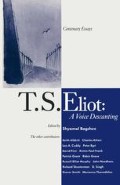Abstract
That T. S. Eliot’s poems recreate journeys marked by recurring images of circles is hardly a new discovery. However, after decades of criticism, we have only now begun to explore the possibility that the circular vision and structure of T. S. Eliot’s poetry depend, to a great extent, on the unique fusion of the two supreme allegories in Western literature — Homer’s Odyssey and Dante’s Commedia — with the peregrine tradition that evolved from those works. At Harvard College Eliot was made aware in 1909–10 of the universal and encompassing nature of allegory, specifically in Professor Neilson’s course in the ‘History of Allegory’ and the Chaucer course which, according to Eliot’s class notes on Troilus and Cressida gave him new insights into ‘the Troy Story from Homer to Shakespeare’.2 Eliot himself pointed to the essential function of allegory in the ordering and expression of emotion and used Homer and Dante as models of creative excellence throughout his prose. I have already discussed in some detail the role of the classical tradition originating with Homer and the particular function of the Ulysses figure from Homer to James Joyce in defining many of the themes and ironic heroes in Eliot’s early poems;3 and considerable scholarship has been presented on Dante’s place throughout Eliot’s work.4 However, the circular structure of these allegories and their impress on the secular subtext and narrative form of his major poems have yet to be fully examined.
‘I have sought to understand myself.’
Heraclitus1
Access this chapter
Tax calculation will be finalised at checkout
Purchases are for personal use only
Preview
Unable to display preview. Download preview PDF.
Notes
Lois A. Cuddy, ‘Eliot’s Classicism: A Study in Allusional Method and Design’, in Shyamal Bagchee (ed.), T. S. Eliot Annual No, 1, pp. 27–62 ( London: MacMillan, 1990 ).
T. S. Eliot, The Waste Land A Facsimile and Transcript of the Original Drafts, ed. with Intro. by Valerie Eliot (New York: Harcourt Brace Jovanovitch, 1971). Cited in the text as WL (Facs.)
T. S. Eliot, The Family Reunion in The Complete Poems and Plays (19091950) (New York: Harcourt, Brace and World, 1952) 229. All Eliot quotations will be from this edition unless otherwise specified.
Lois A. Cuddy, ‘Sounding the Secular Depths of Ash-Wednesday: A Study of Eliot’s Allusional Design and Purpose’, Studia Neophilologica, 55 (1983) 167–79.
Dante Alighieri, *Inferno, trans. John A. Carlyle ( London: J. M. Dent, 1909 ).
David Hume, *Enquiries Concerning the Human Understanding and Concerning the Principles of Morals ( Oxford: Clarendon Press, 1902 ) 64.
Dante Alighieri, Inferno and Purgatorio trans. and comm. John D. Sinclair (New York: Oxford University Press, 1961) II, 22–4.
John D. Sinclair, commentary to Purgatorio 253.
T. S. Eliot, The Confidential Clerk ( New York: Harcourt, Brace, 1954 ) 4.
T. S. Eliot, ‘Preface’, in Transit of Venus by Harry Crosby (Paris: The Black Sun Press, 1931) viii-ix.
Grover Smith, T. S. Eliot’s Poetry and Plays: A Study in Sources and Meaning ( Chicago: University of Chicago Press, 1974 ) 150.
Henri Bergson, *Creative Evolution trans. Arthur Mitchell (New York: Holt, 1911) 27. Passage underlined and marked in margin by Eliot.
Joel E. Spingarn, *A History of Literary Criticism in the Renaissance ( New York: The Columbia University Press, 1908 ) 40.
T. S. Eliot, Knowledge and Experience in the Philosophy of F. H. Bradley ( London: Faber & Faber, 1964 ) 104.
T. S. Eliot, Dante ( London: Faber & Faber, 1929 ).
Editor information
Editors and Affiliations
Copyright information
© 1990 Palgrave Macmillan, a division of Macmillan Publishers Limited
About this chapter
Cite this chapter
Cuddy, L.A. (1990). Circles of Progress in T. S. Eliot’s Poetry: Ash-Wednesday as a Model. In: Bagchee, S. (eds) T. S. Eliot: A Voice Descanting. Palgrave Macmillan, London. https://doi.org/10.1007/978-1-349-10104-7_4
Download citation
DOI: https://doi.org/10.1007/978-1-349-10104-7_4
Publisher Name: Palgrave Macmillan, London
Print ISBN: 978-1-349-10106-1
Online ISBN: 978-1-349-10104-7
eBook Packages: Palgrave Literature & Performing Arts CollectionLiterature, Cultural and Media Studies (R0)

